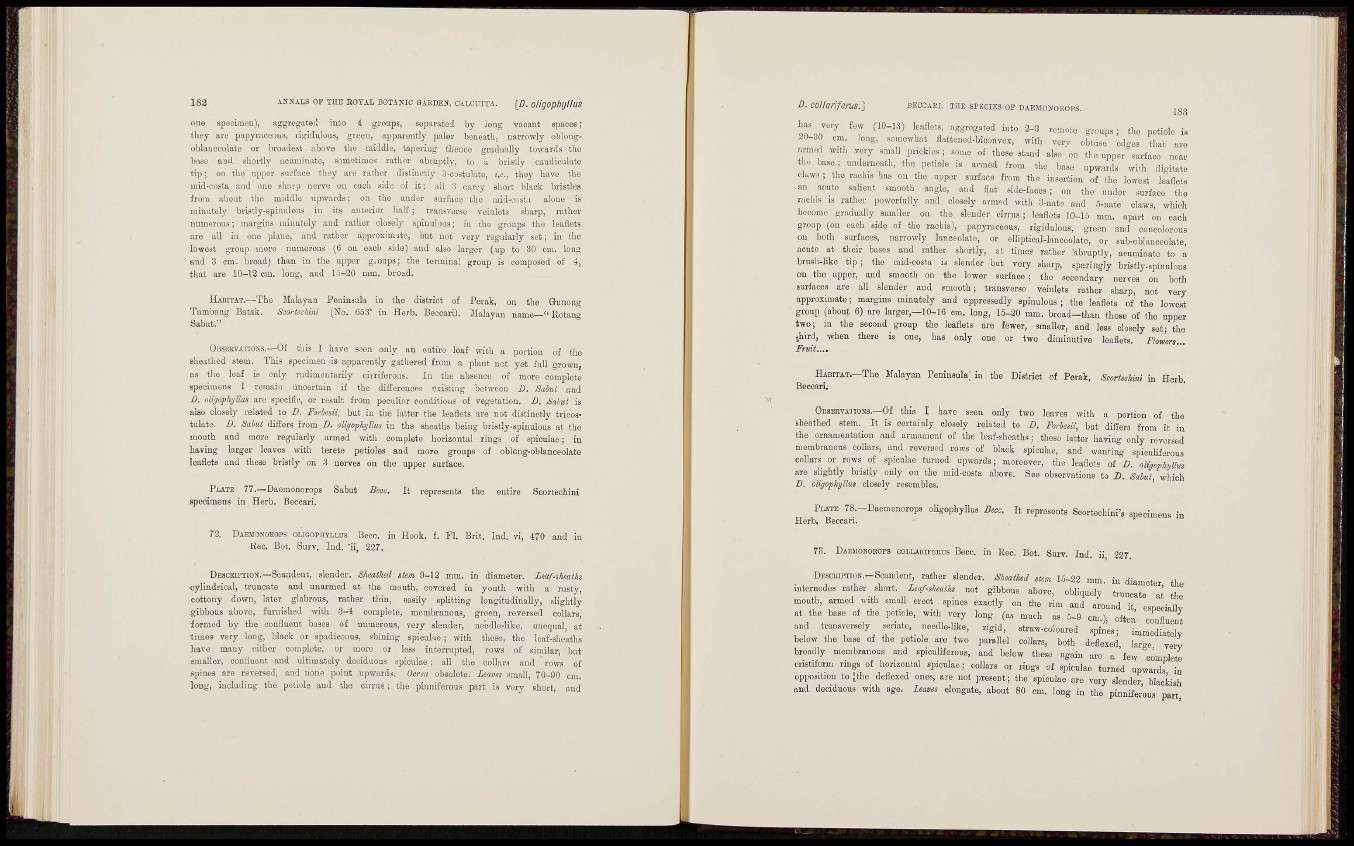
182 ANNALS OF THE ROYAL BOTANIC GARDEN, CALCUTTA. [¿). oUgophyllUS
one specimeu), aggregated into 4 groups, separated by long vacant spaces;
they avG papyraceous, riiiidulous, greeu, apparently paler beneath, narrowly oblongoblauceolate
or broadest above the middle, tapering thenco gradually towards the
base and shortly acuminate, sometimes rather abruptly, to a bristly caudiculate
t i p ; on the upper surface they are rather distinctly 3-castulate, i.e., they hare tho
niid-costa and one sharp nerve ou each side of it; all 3 carry short black bristles
from aboat the middle upwards; on the under surface the mid-costa alone is
minutely bristly-spinuloua in its anterior half ; transverse veinlets sharp, rather
numerous; margins minutely and rather closely spinulous; in the groups the leaflets
are all in one plane, and rather ai)prosim.}te, but not very regularly set; in the
lowest group more numerous (6 on each side) and also larger (up to 30 cm. long
and 3 cm. broad) than in the upper g4.oups; the terminal group is composed of 4,
that are 10-12 cm. long, and L3-20 mm. broad.
HABITAT.—The Malayan Peninsula in the district of Perak, on the Grunong
Tambang Batak. Scortechini (No. 60.3' in Herb. Beccari). Malayan name—" Rotang
Sabut."
OBSERVATIOSS.—Of this I have seen only an entire leaf with a portion of the
sheathed stem. This specimen is apparently gathered from a plant not yet full gi-own,
as the leaf is only rudimentarily cirriferous. In the absence of more complete
specimens I reinaiu nnceriain if the diiferenoftn existing between D. Salut and
D. oligophyllus are specific, or result from peculiar conditions of vegetation, D. Bahut is
also closely related to D. Forbesii, but in the latter the leaflets are not distinctly tricostulate.
D. Sabut difEers from D. oligophyllus in the sheaths being bristly-spinulous at the
mouth and more regularly armed with complete horizontal rings of spiculae; in
having larger leaves with terete petioles and more groups of oblong-oblanceolate
leaflets and these bristly on 3 nerves on the upper surface.
PjoATE 77.—Daemonorops Sabut Bece. It represents the entire Scortechini
fipecimena in Herb. Beccari.
73. DAEMONOEOPS OLIGOPHYLLUS Becc. in Hook. f. Fl. Brit. Ind. vi, 470 and in
Kec. Bot. Surv. Ind. 'ii, 227.
DEacRiPTiOS.—Soaudent, slender. Sheathed stem 9-12 mm. in diameter. Leaf-¡heaths
•cylindrical, truncate and unarmed at the mouth, covered in youth with a rusty,
cottony down, later glabrous, rather thin, easily splitting longitudinally, slightly
.gibbous above, furnished with 3-4 complete, membranous, green, reversed collars,
formed by the confluent bases of numerous, very slender, needle-like, unequal, at
times very long, black or spadiceous, shining spicuke; with these, the leaf-sheaths
have many either complete, or more or less interrupted, rows of similar, but
smaller, confluent and ultimately deciduous spiculae ; all the collars and rows of
spines are reversed, and none point upwards. Oerea obsolete. Leaves small, 70-90 cm.
long, including the petiole and the cirrus; the pinniferous part is very short, and
D. coUariferus.'] J3EC0AKI. THE SPECIES OP DAEMONOBOPS,
f „ (10-13) leafiets, ¡„to 3-3 groups, fhe petiole is
^0-30 cm, long, somewhat Batfened-biconTox, with yerv obtuse edges ftal are
armed w.fl. .ra-y small prickles; some of these stand also on the upper surface near
the base ; m.dernoath, the petiole is armed from the base upwards wilh digitate
clam ; the rachi. las on the upper surface from the insertion of the lowest leaflets
an aeuto salient smooth angle, and flat side-faces; on the under snifaco the
rachis IS rather powerfully and closely armed with 3-natB and .5-nate claws, which
becomo gradually smaller on the slender cirrus; leaflets 10-13 mm. apart on each
group (on each side of the rachis), papyraceous, rigidulons, green and concolotons
on both surfaces, narrowly lanceolato, or elliptical.knceolate, or sub-oblaneeolate,
acute at their bases and rather shortly, at times rather iabruptly, acuminate to a
brush-like t i p ; the mid-costa is slender but very sharp, sparingly bristly-spinulous
on the upper, and smooth on tho lower surface ; the secondary nerves on both
surfaces are all slender and smooth; transverse veinlets rather sharp, not very
approximate; margins minutely and appressedly spinulous ; the leaflets of' the lowest
group (about 6) are larger,—10-16 cm. long, 15-20 mm. broad—than those of the upper
two; in the second group the leaflets are fewer, smaller, and less closely set; the
third, when there is one, has only one or two diminutive leaflets. Flowm
Fruit,,.,
H a b i t a t . - T h e Malayan Peninsula; in the District of Perak, ScortecUni in Herb.
Obsbevatiohb.—Of this I have seen only two loaves with a portion of the
sheathed stem. It is certainly closely related to D, Forlesii, but differs from it in
the ornamentation and armament of the leaf-sheaths; these latter having only reversed
membranous collars, and reversed rows of black spiculae, and wanting spicnhferous
collars or rows of spiculae turned upwards; moreover, the leaflets of D, oliiophiUm,
are shghtly bristly only on the mid-costa above. See observations to D. Sabut which
D. olifiophyllus closely resembles. '
PLATB 78.—Daemonorops oligophyllus Bac, It represents Scorteohini's specimens ,"„
Herb. Beccari. ^
7.3. Daemonorops collariperus Becc. in Rec. Bot. Surv. Ind. ii, 237.
DESOBIPTIoB.-Seandonl, rather slender. Shmthed Mm 15-23 mm. in diameter the
iaternodes rather short. Leaf-,h,.tb not gibbous above, oMiqucly truncate at the
mouth, armed with small erect spiues exactly on the rim and around it, esoeciallv
ot tne base of the pefclo, with very long (as much as 6-9 cm.), often confluent
and transversely senate, needle-liko, rigid, straw-colcm-ed spines- immediatejv
below the base of the petiole are two parallel collars, both doflexed large verv
broadly membranous and spiculiferous, and below these again are a ' f ew complete
cristiform rings of heri.ontal spiculae; collars or rmgs of spiculae turned upwards in
opposition t o ; t l e deflexed ones, are not present; the spiculae are very slender blackish
and deciduous with age. learn elongate, about SO cm. long in the pinniferons part